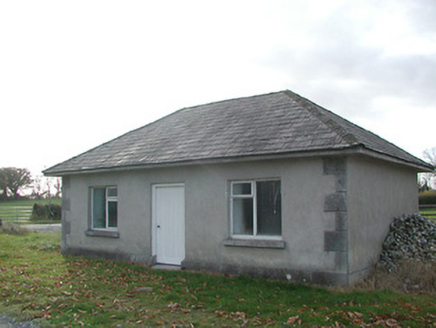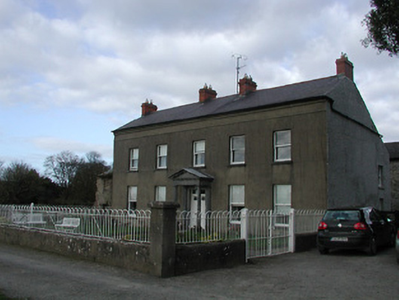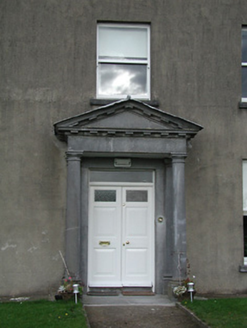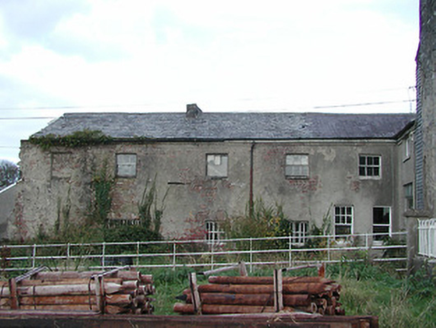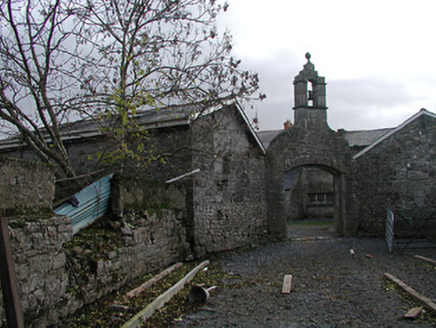Survey Data
Reg No
12402207
Rating
Regional
Categories of Special Interest
Architectural, Artistic, Historical, Social
Previous Name
Sheeptown House
Original Use
Farm house
In Use As
Farm house
Date
1700 - 1773
Coordinates
239903, 150743
Date Recorded
09/11/2004
Date Updated
--/--/--
Description
Detached five-bay two-storey farmhouse, extant 1773, on a T-shaped plan; single-bay (single-bay deep) two-storey return (north). Occupied, 1901; 1911. Burnt, 1923. Pitched slate roof; pitched slate roof (north), terracotta ridge tiles, abbreviated roughcast chimney breasts with red brick Running bond chimney stacks to apexes centred on paired red brick Running bond chimney stacks having corbelled stepped capping supporting terracotta or yellow terracotta pots, and cast-iron rainwater goods on rendered stepped cornice on blind frieze on stringcourse retaining cast-iron octagonal or ogee hoppers and downpipes. Rendered, ruled and lined battered wall to front (south) elevation; slate hung (west) or roughcast (east) surface finish (side elevations). Square-headed central door opening with cut-limestone step threshold, and cut-limestone doorcase with Doric columns on plinths having responsive pilasters supporting dentilated ogee-detailed pediment on blind frieze framing glazed timber panelled double doors having overlight. Square-headed window openings with cut-limestone sills, and concealed dressings framing one-over-one timber sash windows. Interior including (ground floor): central hall retaining carved timber surrounds to door openings framing timber panelled doors; and carved timber surrounds to door openings to remainder framing timber panelled doors with carved timber surrounds to window openings framing timber panelled shutters. Set in landscaped grounds with rendered, ruled and lined boundary wall to perimeter having lichen-spotted "saddleback" coping supporting looped wrought iron railings.
Appraisal
A farmhouse representing an integral component of the domestic built heritage of County Kilkenny with the architectural value of the composition, one occupied (1773) by John Waring (d. 1802) and later described as 'the handsome residence of J. [James] Sandiford Lane [1811-71]' (Lewis 1837 II, 174), suggested by such attributes as the compact plan form centred on a pillared doorcase demonstrating good quality workmanship in a blue-grey limestone; the feint battered silhouette; and the diminishing in scale of the openings on each floor producing a graduated visual impression. The "House and Building Return" Forms of the 1901 Census and 1911 Census describe the property as a First Class Private Dwelling with fourteen windows 'on Front of House' and it is possible that a parapeted attic was eliminated when the farmhouse was reconstructed following an attack (-- March 1923) during "The Troubles" (1919-23). Having been well maintained, the form and massing survive intact together with substantial quantities of the original fabric, both to the exterior and to the interior, including a partial slate hung surface finish, thus upholding the character or integrity of the composition. Furthermore, adjacent outbuildings (----); a trapezoidal walled garden (----); and a nearby gate lodge (----), all continue to contribute positively to the group and setting values of a self-contained estate having historic connections with the Lane family including Samuel Waring Lane (1835-86) 'late of Shipton County Kilkenny' (Calendars of Wills and Administrations 1871, 317; 1885, 455); Robert Carson (----), 'Farmer' (NA 1901); and Edward "Ned" Teehan (1858-1920) 'late of Shipton Kilmanagh County Kilkenny' (Calendars of Wills and Administrations 1920, n.p.). NOTE: Occupied (1942) by Mary Teehan (----) who, as Captain of the Kilmanagh Cumann na mBan, spent most of the Civil War (1922-3) working full time for the cause of Irish Freedom. Having applied for a pension, and having initially had her application rejected, Ms. Teehan wrote to the Pensions Board in 1942 to remind them of the role of women in the cause: "We stood in the gap and had no guns to defend us. The men aught to be proud of themselves [but] I wonder where, or how long would the IRA last, if they weren't fed & cleaned & encouraged by the women".
